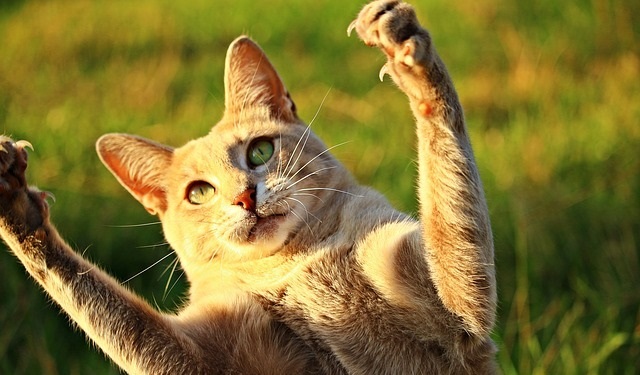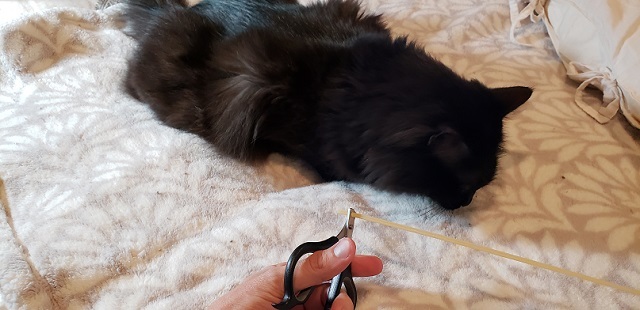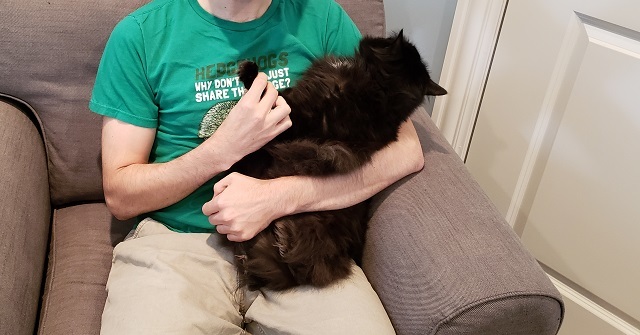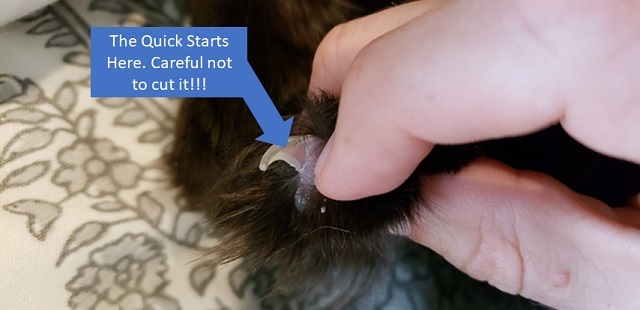
Clipping your own nails is a pretty simple process, grab the clippers and a file and you’re good to go right? On the other hand clipping your cat’s nails can be quite a different experience.
You might have a cat that dreads getting her nails clipped and bolts the second she hears you open the drawer where the clippers are. Or even worse you might have a cat that is a sleeping fur ball of ferociousness.
They’ll let you hold them quietly until you clip the first nail then they freak out and scratch the heck out of your arm! No fun for anyone, especially you and your cat.
So how do you go about ensuring that clipping your cat’s nails doesn’t become a hated experience that results in your cat hiding under the bed every time they see clippers pop out?
There are a lot of things you can do to ensure that your cat will not run off instantly, but they might even become used to getting her nails clipped and relax throughout the process. So check out the quick guide below and start wherever you need to!
How to Clip Your Cat’s Nails Quick Guide
|
|
| Before You Clip | |
| Start Young | |
| Know Your Paws | |
| Know Your Clippers | |
| Sound Acquaintance | |
| Gradual Introduction | |
| The Clipping Process and Tips | |
| #1 Clipping Position | |
| #2 Use the Right Clippers | |
| #3 Clip The Nails | |
| #4 Never Cut Too Much | |
| #5 Wear Protective Clothing | |
| #6 Additional Tips | |
| In Closing | |
| Anything Else to Consider? | |
| Wrapping It Up |
Start From a Young Age
A s with any habit you’d like to instill in your cat, if you can start from when they are a kitten then that is ideal.
s with any habit you’d like to instill in your cat, if you can start from when they are a kitten then that is ideal.
Starting young makes your cat easier to handle and less likely for them to cause any serious injury and it gets them used to it before they are large and their little claws have turned into razor blades a quarter of an inch long.
Many of you will adopt cats that are already adults and you won’t have a chance to acclimate them to the process in the same way you would a kitten.
So let’s talk a little bit about an adult cat that isn’t yet used to getting their nails clipped.
Before You Start Clipping Know Your Cat’s Paws
If your cats are anything like mine, even though they are docile for the most part, they really don’t love having me touching their paws. Cat’s paws are unique in that they incredibly sensitive compared to our human feet shoved inside our shoes.
They are incredibly important to cats because without them they can’t hunt meaning they really can’t live. Given this they are very protective of their paws and likely to pull them back the second you touch them.
 So let’s get started with getting your cat used to your touch. Take one of your cat’s paws between your fingers and give it a very gentle touch, if she is accepting then a light squeeze is ok to proceed with.
So let’s get started with getting your cat used to your touch. Take one of your cat’s paws between your fingers and give it a very gentle touch, if she is accepting then a light squeeze is ok to proceed with.
If your cat pulls her paw away simply let go and wait until she is still again. This may take some attempts before she is comfortable with you touching her paws at all. I’d recommend having lots of treats handy and providing them freely during this stage.
Once you’re able to touch her paws effectively then you can try to extend a nail out of her paw. You can do this by pressing from the bottom and tap of the paw on one of the paw pads.
Note: It may also help to play with your cat for 15-30 minutes and then let her calm down after the session and attempt this while she is sleepy/lethargic.
Get Acquainted with the Clippers
Cats love to get slowly acquainted with new things. Slowly exposing your cat to a new set of clippers, even when they aren’t in use, is a great strategy to help things along.
You can leave the clippers in her bed or her favorite place to sleep so that her scent ends up on the clippers. It may sound silly to do this, but it should help things along because she won’t see another brand new object when you get started with clipping!
Stop, Wait, What’s That Sound?
While you may not think about it because the sound of nail clippers doesn’t bother you, it is worth noting that cats can associate the sound with a bad experience. So let’s get these two things onto a good standing in your cat’s mind.
When your cat is nearby or in your lap you can snip a few pieces of uncooked spaghetti with the clippers. Then you can reward your cat with a treat after the clipping of the spaghetti to make her associate the sound with good things.

You can then move along. Next, while massaging one of your cat’s toes, gently press her toe pad. When the nail extends, clip the spaghetti with the clippers while still holding your cat’s paw gently. Now release her toe and quickly give her a treat.
Special thanks to PetMD for this idea!
Gradual Introduction To Clipping
As we all know cats don’t like change. If clipping your cat’s nails is a new experience then you’ll want to ensure you start slowly and provide lots of positive reinforcement. What do I mean by start slowly?
Well your cat has a heft number of nails, 18 to be exact. You’ve got 5 on each front paw and 4 on each back paw. If you’re just getting started with nail clipping you may want to clip only one or two nails the first time and then let your kitty go and reward her with treats.
This may take a while to get your cat fully used to nail clipping and some cats may never enjoy the process completely, so be sure to add in nails gradually.
One thing worth noting is that you’ll need to cut the front nails a lot more often than the back nails. Cats sharpen their front nails more frequently on their scratching posts and they will need far more attention to keep them manageable!
How to Clip the Nails
#1 Nail Trimming Position

If you’re going to be trimming the cat’s nails by yourself, the cat will need to sit on its rear on your lap, facing away from you, while you hold its paw with one hand (and, eventually, the clippers with the other).
 #2 Use Nail Clippers Designed for Cats & Be Sure They are Sharp
#2 Use Nail Clippers Designed for Cats & Be Sure They are Sharp
It may go without saying, but just in case. To trim your cat’s nails, you’ll need a pair of nail clippers designed to clip cat claws. Don’t products that aren’t specifically designed for cat nails as you could end up injuring your cat. The only real exception is for very kittens where you may use a pair of human nail clippers while their nails are still tiny. I have used my scissor style clippers on foster kittens under 8 weeks and it works just fine.
There are several different styles of nail clippers, all of which largely do the same job. The most common two types are:
- Guillotine clippers: Similar to the actual guillotine these use an entry slot for the nail and when you squeeze the handles together it shoves a single sharp blade forward to cut the nail. These are great clippers all around, but if your cat has really long nails that are curved like talons they can be a bit of a hassle to get the nail into the slot. The clippers in the shot above are guillotine clippers.
- Scissor clippers: They look just like scissors, pretty straight forward. You can get them in various sizes. You’ll want to use smaller clippers for smaller/younger cats and larger ones for bigger or older cats that get trimmed less often. The clippers used in step 3 are scissor style clippers.
Ensure the clippers are sharp. If the clippers are sharp the cat won’t feel the quick clip. Your cat’s clippers will start to dull after extensive use. Be sure to replace them if you notice your clippers aren’t cleanly cutting the nails. Dull blades is likely the cause.
#3 Now For the Clipping
You’ve got your cat in position, you’ve got your clippers in one hand. Now it is time to clip. All your conditioning and practice now comes into play. Press one of your cat’s paws to extend the nail and then find the quick, slide your clippers into place, well away from the quick, and clip.
Ideally you’ll want to set your clippers up to cut from the bottom of the nail to the top of the nail, not the other way around. This will help minimize splitting the nails which can result in the clippers sliding or pushing a lot more pressure onto the quick which can be painful.
Be sure to press firmly and quickly once the clippers are positioned. This ensures a clean cut for the nail.
As discussed above you may only be able to clip one or two nails the first few times. Be patient! It might require multiple sessions over multiple days to get to all of the nails the first few times.
#4 Never Cut too Much

The pink part of a cat’s nail is called the quick and you’ll want to be really careful of this. Most cats will react very poorly if you cut it. This is because it is extremely painful and actually has nerves and blood flowing through it.
If you happen to cut this your cat will bleed and your cat will definitely start to associate nail clippings with a bad experience. DO NOT CUT THIS AREA. Only cut the excess part of the nail.
As with many things in life, you’re far better off being extra careful and leaving extra nail on your cat than you are being aggressive and injuring your cat.
I don’t know how many positive experiences it takes to fix a negative one, but in general most cat swill consider every nail clipping a negative experience. Do your best not to make it any worse.
If you do accidentally cut the quick, any bleeding can be stopped with a styptic powder or gel. It’s a good idea to keep it nearby while you trim, especially if you’re new to it.
#5 Get Smart and Wear Protective Clothing
If you’re a new cat owner I’d also highly recommend you wear protective clothing when trimming your cat’s nails. No, you don’t need Kevlar or anything or a SWAT helmet.
Wear long sleeves and multiple layers so that if your cat’s claws do come out or if they do react poorly you’ve got a certain level of protection. I aim to wear a thick hooded sweater and jeans while we trim just on the off chance a stray claw comes my way.
If you’ve got two people for your trimming and you’re working with a new cat you might want to have the cat holder wear pot mitts just for the sake of safety the first few times.
The person with the clippers clearly can’t wear these so they’ll want to be very observant of the cat’s behavior to watch for warning signs!
#6 Additional Thoughts If It Still Isn’t Going Well:
The Towel Taco: While not ideal for clipping, the classic towel taco can really help minimize your cat’s movement during the clipping process. The difficult part is leaving a front paw out to clip while you wrap the rest of your kitty up. That being said, this can be a very helpful method for trimming and clipping because it minimizes the potential threats!
Tag Team The Nail Clipping: If you have another person around this can make nail clipping a breeze compared to attempting it solo. I’ll freely admit that I’ve been lucky in that I always have another person to hold the cat while I perform the clipping. This makes the whole process undoubtedly easier and I highly recommend you bring help when you can.
Ask Your Vet Team: One thing I absolutely love about my Vet is that every time I take my cat in she gets a nail clipping free of charge. Obviously this isn’t often enough to cover me for the year. But I’d highly recommend you ask your vet if they can do a complimentary nail trimming while you are already in. They almost always have a multiple person team and they are very experienced in handling difficult felines. This might save you one or two clipping sessions a year.
Hire a Groomer: Last but not least, if you aren’t having any luck trimming your cat yourself you can always hire a groomer to do it. I’d personally recommend trimming your cat’s nails every two weeks and this can add up to be quite expensive if you have a groomer do it each time. But if your cat is horrified of you trimming her nails then this may be a solution.
One other thing to keep in mind is that if you do decide to pursue this route you’ll likely have to load your cat into the carrier and transport her on a consistent basis. Some cats really dislike this experience so you may want to check out my article on how to get cats into carriers the easy way.
Anything Else Worth Noting
Last but not least remember that your cat’s nails will grow her entire life and this is something you’ll need her to get used to at some point. Even if you find trimming her claws difficult you should not declaw your cat.
It is horribly painful for your cat and can cause all sorts of both health and behavioral issues.
I’d also suggest you ensure you provide a high quality scratching environment for your cat. This will ensure that your cat doesn’t end up scratching your furniture or your carpet and instead focuses on the right items that you specifically want them to scratch.
Check out this article for more details on cat scratching.
Wrapping it Up on Nail Clipping
As you can see there’s a lot to take into account when you want to clip your cat’s nails and likely you won’t be able to do this on your own time! Cats have minds of their own and love to make the simplest of tasks as complicated as they can. They do rule the household after all.
I’ve personally been blessed with cats at home that are pretty easy to trim and that I have another person to trim with, but trimming a cat alone at the shelter is quite a task when it is necessary!
Also be sure to read up on other grooming practices like brushing your cat on a consistent basis as well. If you have any questions about nail clipping or if you have any experiences you’d like to share then please leave a comment below or write me directly at Craig@StuffCatsWant.com.
StuffCatsWant.com is a participant in the Amazon Services LLC Associates Program, an affiliate advertising program designed to provide a means for sites to earn advertising fees by advertising and linking to Amazon.com.

